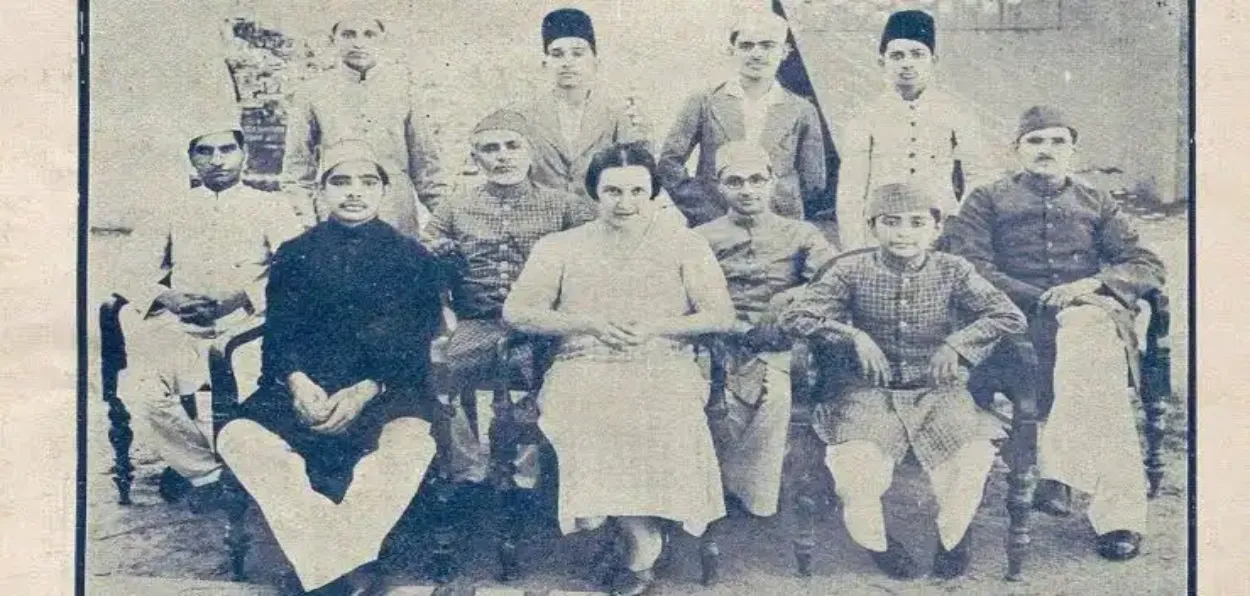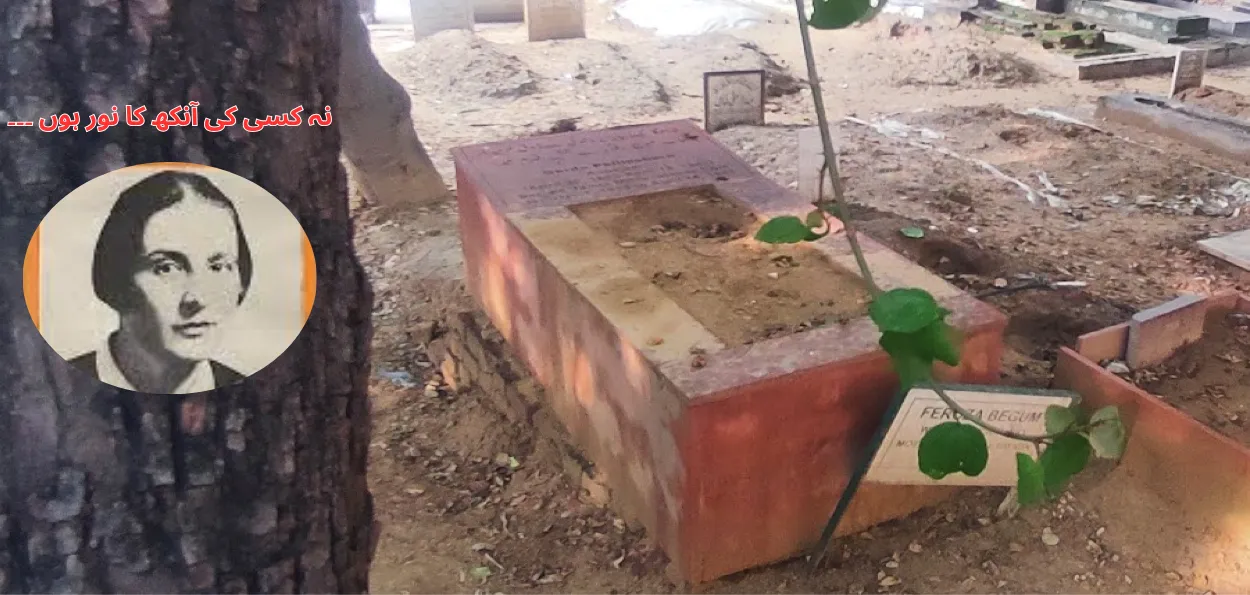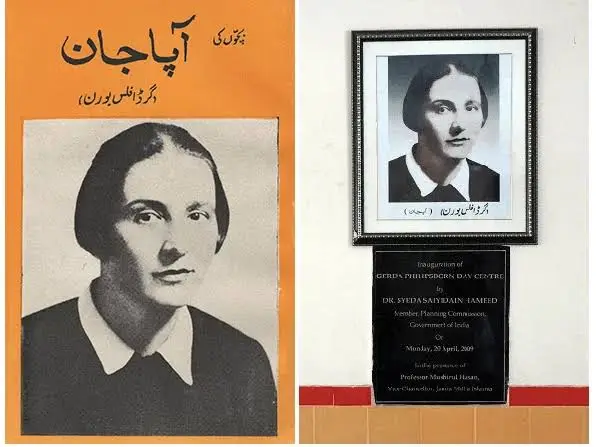
Mansooruddin Faridi - New Delhi
“I am neither the light of someone's eyes nor the resolution of anyone's heart” This epitaph is inscribed in the grave of the only jew to be ever buried in a Muslim cemetery in India. The tombstone in the graveyard of Jamia Milia Islami, Delhi, bears her name: Gerda Phillipborn. She was once called 'Apa Jan' in Jamia Millia because she had dedicated the last ten years of her life to this institution.
Greda had wished to be buried at Gulshan Firdous, the JMI cemetery. Though her picture adorns the wall in the main office of Jamia Millia Islamia, not many know that she was called the First Lady of Jamia Millia as she was the first woman to be associated with this institution. Gerda Phillipsborn came from Germany before World War II and became part of Jamia Millia. India was Germany's rival in the War, and therefore the British government put her in jail on suspicion of being a spy. She served her prison term, and on being released, she dedicated the rest of her life to the institution, and after her release, she immersed herself in the JMI.
JMI records mention her services and dedication, a detailed tribute to this Jewish woman's love and service to Jamia Millia Islamia is best written in Sughra Mehdi's book ' Basat Ki Apa Jan '.
Born in 1895 in the prosperous trading town of Kiel in northern Germany, Philipps Born's father and uncle had a clothing and ready-made clothing business. The family was known as "assimilated Jews", meaning they did not wear their religion on their sleeves.

Grave of Gerda Phillipborn at Jamia Milia cemetery
Later, when the family moved to Berlin, Gerda became interested in opera and theater and finished school in 1912/13, because at that time women were not allowed to attend college. Her goal was to become a professional opera singer, so she entered the Berlin Stern Conservatory in 1908. As an opera singer, she was connected to musicians and artists. Through her partner, who worked with Albert Einstein, she was also connected to scientists. She was a friend of the Jewish philosopher Martin Buber and the writer Franz Kafka. She took her Indian friends to concerts, operas, plays, art exhibitions, and schools.
Gerda Philipsborn's connection with India developed after meeting three Indians - Dr. Zakir Hussain, Abid Hussain, and Professor Muhammad Mujib - in Berlin. A seemingly coincidental meeting between a Jewish-German woman and three Indian-Muslim youths changed not only the woman's life but also, to some extent, the university.
In the 1920s, they met at a party at the house of Sahasani Chettupadhyay (Sarojni Naidu's younger sister) and her husband, A.C.N. Nambiar. Gerda Philipsborn and the three Indians were educated and filled with the spirit of liberating their country and serving their people. Among them, Dr. Zakir Hussain, who belonged to a landowner family of Hyderabad, had studied at Aligarh Muslim University and was doing his doctorate in economics in Berlin. Abid Hussain had a doctorate in education from Germany, while Muhammad Mujib was a graduate of history from Oxford and was learning printing in Berlin.
In 1926 her friends returned to Jamia Millia. Gerda Phillipsborn felt lonely. Her mother had died, her father's business had collapsed, and her siblings were busy with their own lives. She refused to marry a Jewish partner and move to America. She was drawn to social experiments and utopian promises. This passion took her to Palestine, but she soon became disillusioned with the political trends of the Zionist movement. At that time, the situation in Germany was changing rapidly, and the Nazis were on the rise. Phillipsborn was also seeing that Nazism was about to rise in Germany, so she decided to go to India with her friends and informed her friend, Dr. Zakir Hussain, in a telegram. She set foot in Jamia Millia on January 1, 1933.

Book on Gerda Phillipborn and her portrait hung on the walls of Jamia Milia Islamia
The news about Phillipsborn coming had spread, and everyone at the Jamia Milia awaited the arrival of a "Memsahib" (a white woman). JMI was not just an educational institution, but the people working here lived here like a family; there was no hierarchy. Phillipsborn also became a part of this family. She was saddened to see that Indian women lived within the walls of the house and were segregated in public spaces.
The late Sughra Mehdi, in her book Apa Jaan, has mentioned the life of another teacher of Jamia Millia, Abdul Ghaffar Madhuli, who in his autobiography "The Life of a Teacher," wrote that Phillipsborn was interested in serving children.
Similarly, Dr. Zakir Hussain's close friend Professor Mujeeb has also written that her exemplary work in JMI. She would go to go to the homes of Jamia workers, chat with them to share their joys and sorrows, and make the women realize the importance of Jamia and the need for them to join in. She also explained to them that Muslim women can do all the work in purdah.
Sughra Mehdi writes that 'Apa Jaan' was lodged in "Khaksar Manzil" and later the Ahmednagar Fort. Her arrest enveloped the JMI with sadness. Those who were associated with India's freedom struggle were well aware of the hardships of the Ahmednagar Fort. Some high-ranking people used their influence to meet her and also carried gifts made by the teachers and students og the university. Her release was celebrated at the Jamia Milia Islamia.
After her release from Ahmednagar Fort, she was again committed to her mission; her humble beginnings had become prosperous. She actively participated in the activities of Jamia Millia, running around as long as she was healthy. Later, she was diagnosed with cancer, and she became weak and yet she continued her work from her bed. One of the incidents before Gerda Phillipsborn's death is the one in which she sent Dr. Zakir Hussain to collect the promised grant for Jamia Millia, as she could not go due to her bad health. When Zakir Hussain returned with the letter, she smiled peacefully in the face of severe pain, and it was her last smile. When she died in April 1943, the academic community of Jamia was plunged into mourning.
ALSO READ: Nepal: Gen Z picks Sushila Karki as Interim PM
Sughra Mehdi unveiled her book on the occasion of the institution's 75th anniversary. She said, like Apa Jaan's life, it is clear that service to humans is not bound by one's religion and nation. Since the path of public service is the path that takes a person to God. If we explain this to the children from the beginning and present a practical example to them, then this will be remembered by them, and they will act on it when they grow up.
